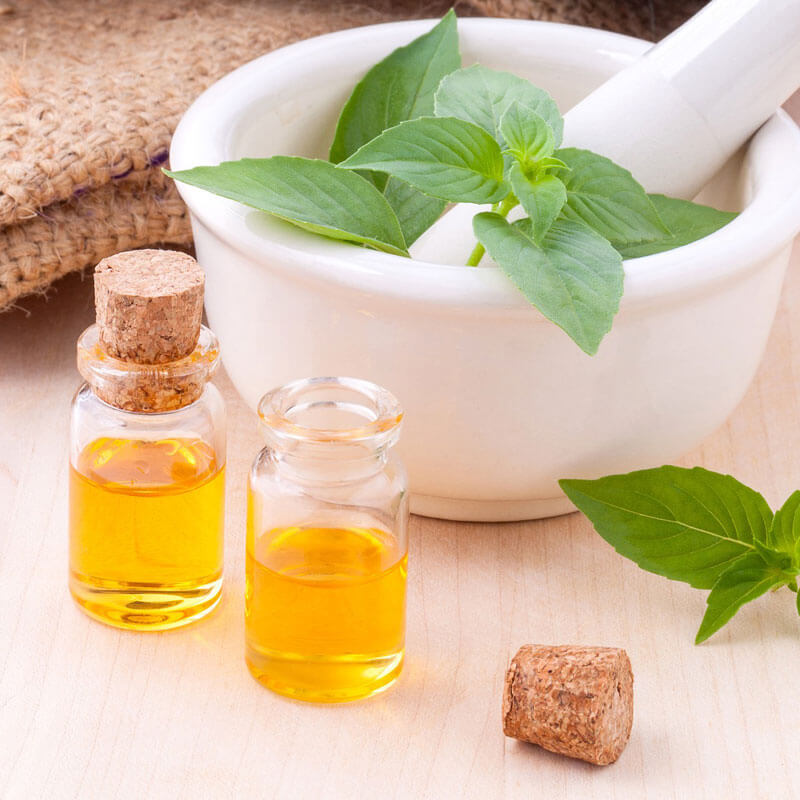With its licorice-reminiscent flavor and scent, anise oil benefits brings a refreshing and unique element to your single-oil use or combination blends. Here, we’ll learn how to differentiate true anise oil uses and incorporate them into your wellness routines.
Table of Contents
Anise Plant Profile
When a common name is shared between plants, we often make the mistake of assuming they are related, similar, or even interchangeable. None of the above are necessarily true. Anise and star anise are examples, sharing the common name of anise, but they are entirely different plants. Latin names help us to narrow down exactly which plants we are dealing with and understand how to use them.
True anise is the plant of focus today, with the Latin name Pimpinella anisum. It’s part of the dill family, a group of almost spindly annual and sometimes perennial herbs with “umbel” shaped flowering heads and strong aromatic compounds.
Star anise, on the other hand, is Ilicium verum, a spice derived from the pods of an evergreen tea.
Whole Herb Use
Anise seeds are usually the part of the plant used, and have been for generations. Traditional medicine uses anise seeds for “carminative, aromatic, disinfectant, and galactagogue” purposes, as well as menstrual issues, diabetes, inflammation, and more digestive issues. (1)
A good example of anise whole-herb use is found in a 2007 article in the World Journal of Gastroenterology. An extract of the seeds was prepared and tested on gastrointestinal health. The researchers found that it could protect the gut against ulcers and lesions, perhaps thanks to its abilities as an antioxidant. (2)
Like its relatives dill and fennel, anise is known for its digestive properties, particularly when the seeds are used in extracts or powders. However, there is a good deal of essential oil content found in those seeds that can be distilled for varying and sometimes more targeted uses and benefits of anise oil.
5 Health Benefits of Anise Oil Uses
Now that we know what anise oil is why should we use it at all? Here are five benefits of anise oil and uses that are backed by research.
1. Anti-inflammatory Pain Relief
A major constituent of anise seed oil, anethole, was tested in animal models in 2014 for its pain-relieving abilities apart from simply making the individual feel sedated. The results were fairly clear that the compound helped to lessen pain without creating sedation, most likely thanks to anti-inflammatory actions. (3)
This backs traditional uses as a pain reliever, particularly as an oil for muscle pain and inflammatory discomfort.
Indications: Massage oil, diluted topical application.
2. Bronchodilator
In a similar vein, anise essential oil appears to relax muscles, which would also contribute to pain relief in many cases. To watch this action take place, researchers tested anise essential oil on isolated guinea pig tracheal chains to evaluate the tracheal muscles’ response to the application. The essential oil showed “significant relaxant effects.” (4)
This study demonstrated a bronchiodilatory response. In other words, breathing could improve in the case of inflamed or congested airways.
Indications: Topical massage and inhalation during respiratory illness.
3. Antifungal Options
Topical fungal infections are uncomfortable and difficult to get a handle on, and systemic yeast can be devastating. Essential oils are often effective against fungal problems, sometimes even more so than other options. Anise in various forms, including the essential oil, seems to be effective against multiple kinds of fungi in vitro, including the dreaded Candida albicans. (5)
Indications: Diffusion, diluted topical treatments, periodic inclusion of one or two drops in a lipid dilution mixed into a full culinary recipe.
4. Antibacterial Powerhouse
Last but not least, of the anise essential oil actions we’re highlighting today, antibacterial effects steal the show. Antibacterial essential oils are incredibly useful, from respiratory illnesses to skin treatments or countertop cleaning solutions.
Anise is one of the essential oils with the distinct benefit of being active against bacteria in the mouth. In one study, a decoction of the whole seed was used to demonstrate antibacterial activity. (6) This gives us reason to believe that the essential oil, diluted properly, can add to an antimicrobial oral rinse.
With oils that have content like estragole that require a bit of extra attention to caution, synergy can allow you to use a little less of it while actually obtaining more benefits. Synergy is especially important for antimicrobial benefits in vitro, and anise demonstrates this perfectly. In a 2008 study, anise essential oil demonstrated increased antibacterial benefits when paired with thyme essential oil, one of the best-loved antimicrobials out there. (7)
5. Nausea Relief
If you think back to the last bout of nausea you struggled with, you’ll remember sensitivity to smells. The right, or wrong, scent can have a bigger impact during nausea than under normal circumstances.
A 2005 study combined multiple anti-nausea essential oils – anise, fennel, Roman chamomile, and peppermint – to create a soothing blend for patients in hospice care. While it was not their single treatment for nausea, a majority of the patients who used the blend found improved nausea symptoms, and aromatherapy may have contributed to that overall success. (8) As a non-invasive application, we should utilize our bodies’ ability to turn something as simple as a scent into a healing tool.
Indications: Personal inhalers, aromatherapy diffusion, on the collar of a shirt.
Anise Essential Oil Interactions
On top of the mild estragole concerns with ingestion, anise essential oil carries interactions with pharmaceutical drugs, as well. Some common interactions include drugs that act on the central nervous system (e.g., diazepam) and blood thinners. (9) Acetaminophen and caffeine may also change in effects when consumed alongside anise essential oil. (10)
Anise may also include phytoestrogen properties, which isn’t actually a problem in most instances; just use caution or speak with a physician before use if you are battling an estrogenic cancer.
Always discuss supplements and essential oil use with your doctor, especially if you are on medication, and learn full interactions before beginning to use essential oils internally. Keeping the dose to culinary levels helps to maintain safety, but drug interactions should always be a top concern.
Estragole Essential Oil Content
It’s important to note that anise essential oil is a strong source of estragole, which we’ve discussed with fennel and tarragon essential oils as a concerning compound.
To quickly summarize, estragole itself has been flagged as a toxic compound, potentially causing cancer or creating other kinds of havoc in the body. Two important distinctions should be made, however, before writing off these important substances: 1) we don’t consume estragole on its own, and 2) the amounts needed to replicate that risk are almost impossible to achieve. Nevertheless, further studies are needed to define both the nature and implications of the doseresponse curve in rats at low levels of exposure to ES. In the meantime exposure of ES to sensitive groups such as young children, pregnant and breastfeeding women should be minimised. (12)
The absolute safest way to get around the controversial effects of estragole content is to consume only the whole seed, which contains other compounds thought to mitigate the risks, or the essential oil only in very small quantities. Pregnant and nursing women and children should avoid internal use to be safe. Anyone with a seizure disorder should use caution.
DIY Anise Oil Uses and Preparations
You can utilize anise for its strongest benefits in a number of ways.
- Careful culinary inclusion of a drop or two properly diluted in lipids and added to a recipe, remembering that less is more with essential oils
- Antimicrobial respiratory inhalation, combined with eucalyptus or cinnamon
- Antimicrobial mouthwash, with cinnamon, myrrh, and peppermint
- Dilution into a carrier oil for a topical respiratory relief massage oil
- Whole-herb and occasional essential oil culinary inclusion for digestive wellness
Become familiar with the safe uses of anise, as well as the GC/MS analysis from your essential oil source, which can tell you exactly how much estragole is in your anise essential oil. Then have fun experimenting with the distinctive licorice flavor and scent as you blend it with more familiar essential oils.
- http://www.ncbi.nlm.nih.gov/pmc/articles/PMC3405664/
- http://www.ncbi.nlm.nih.gov/pubmed/17373749
- http://www.ncbi.nlm.nih.gov/pubmed/25506382
- http://www.ncbi.nlm.nih.gov/pubmed/11137352/
- http://www.ncbi.nlm.nih.gov/pubmed/16375827
- http://www.ncbi.nlm.nih.gov/pubmed/16935829
- http://www.ncbi.nlm.nih.gov/pubmed/18226481
- http://www.sciencedirect.com/science/article/pii/S0962456205000706
- http://www.ncbi.nlm.nih.gov/pubmed/22926042
- http://www.ncbi.nlm.nih.gov/pubmed/26619825
- http://www.ncbi.nlm.nih.gov/pubmed/13680814
- http://www.ema.europa.eu/docs/en_GB/document_library/Scientific_guideline/2010/04/WC500089960.pdf







